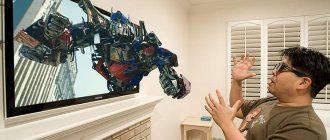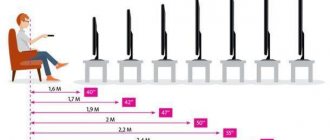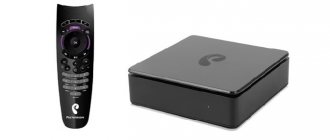TVs are becoming more and more affordable: for example, the simplest 50-inch models now cost about 20,000 rubles. It seems to many that the larger the screen, the more impressions, the deeper the immersion in what is happening. But actually it is not. Look at the layout of any cinema: the most expensive tickets are always in the middle rows. If you sit on the first or second, the picture will be too big and watching the movie will be extremely uncomfortable. Therefore, you need to find the optimal TV diagonal, based on the layout and furnishings of your apartment. But how to choose a TV diagonally?
What happens if you choose the wrong screen diagonal?
Of course, nothing catastrophic. But over time, you will begin to pay attention to some nuances.
My eyes get tired. Remember our parents’ advice: “don’t sit close to the TV.” Indeed, when a bright and contrasting image is too close, the eyes quickly get tired. If you sit too far away, you will have to strain your eyes even more.
The picture quality will be worse. This applies to cases where the distance between the TV and the chair/sofa is too small. With a small screen resolution (say, HD Ready), the image will not be clear enough.
Viewing comfort is lower than usual. Again, this happens when the TV is too close.
It's like in a movie theater: if you're sitting in the front row, you have to periodically turn your head because you can't catch the entire screen in your field of vision. With a large diagonal TV it’s about the same.
Selecting the optimal distance
When choosing a TV, you should never rush. It is necessary to calmly and carefully evaluate all factors that may subsequently affect the quality of viewing. For example, it may be that the screen is too large or the inability to change the distance from the sofa to the monitor. Many people wonder at what distance they can watch TV without compromising comfort and safety.
Large images at close range are difficult for the eye to fully comprehend. When approaching too closely, traces of interference and individual dots become noticeable. Therefore, the screen diagonal is selected depending on the distance between the TV and the viewing location.
In the days of devices with picture tubes, the viewing distance was determined by the length of the diagonal, multiplied by 5. The resulting value was considered the most optimal and safe for vision. With the advent of modern televisions, changes have been made to this formula. Now, to calculate a comfortable distance, a coefficient of 3 is used. This value is considered average, and all deviations from it depend on the layout of the apartment, signal stability, and screen resolution.
The purpose for which the device is purchased is of great importance. Home theaters, for example, have a shorter distance than a conventional device. Due to this, the effect of maximum presence is achieved.
What TV diagonal to choose in accordance with the viewing distance? Using a table will help make your choice easier. In it, all quantities are closely related to each other and correspond to various categories of television signals. In practice, the recommended values can be changed upward or downward.
How to choose a TV diagonal for a room?
To accurately determine the diagonal size, you need to know where exactly you would like to place the TV. Then measure the distance from the main place where they will watch TV to the “box” itself. And finally, follow the “golden rule”: for the most comfortable viewing, you need to install the TV at a distance of 2.5-3 its diagonals . The diagonal of a TV is measured in inches; 1 inch is equal to 2.54 cm.
What does this mean in practice? For example, from your favorite sofa to the opposite wall, where the TV is supposed to be located - 3 meters. This is 300 cm. We divide this figure by 2.5 (remember about 2.5-3 diagonals), then by 2.54 (convert to inches) - we get approximately 47. That is, in a particular case, the correct choice would be a TV with a diagonal of 47-48 inches.
300 / 2,5 / 2,54 = 47,24
Such TVs cost from 22,000 rubles. and higher.
This math is true for devices with HD Ready and Full HD resolution screens. But today there are already quite a lot of models with 4K. How are they different in terms of placement? Since the image clarity is higher, even from a close distance it will not look blurry. That is, theoretically, the same 48-inch TV can be watched from 2-2.5 m without problems. But this is only one point out of the three that we cited above. A huge image will also be annoying if you are too close to it. Here, for example, are Samsung's recommendations for the ratio of diagonals and distances.
By the way, when we talk about 4K TVs, we mean the presence of 4K content. Because with it the picture resolution will be 3840*2160. What happens if there is no such content? Then the electronics will begin to stretch, for example, standard Full HD to 4K resolution. Some models do this well: the difference in quality is not very noticeable. But sometimes after “optimization” the boundaries of objects begin to look blurry, and at close range you can notice “pixelation”. That is, if you place such a TV too close, the same problems will arise as with conventional TVs.
CONCLUSION. With any TVs, use the classic formula: the distance to the screen should be 2.5-3 times the size of its diagonal.
Features of choice
The size of the TV affects your viewing comfort. If there is enough space in the room, you should not waste time and install a small plasma. The size and purpose of the room will help you find the middle ground.
Kitchen
A small TV looks natural in a small room. Important points:
- choose a model with a wide viewing angle so that the image is clear from anywhere in the room;
- Choose a panel with high-quality sound so you can hear it while the steaks are sizzling or the blender is running.
You should also consider lighting - place the plasma so that sunlight and lamp light do not distort the image.
A screen with a diagonal of 28-32 inches is suitable for the kitchen. This is the standard size of space for a built-in TV in kitchen sets.
Living room
The largest room in an apartment or house is the hall. It seems logical to hang a plasma with the largest diagonal in the living room. Why this choice is wrong:
- the image becomes tiring if the screen is wider than the field of view;
- At close range, the picture disintegrates into pixels; Full HD clarity cannot be appreciated.
A diagonal of 40-55 inches is most comfortable for the living room. For an 80-inch plasma, the length of the room must exceed 3 meters.
Bedroom
A huge plasma in front of the bed or on the ceiling is also a test for vision. To turn a bedroom into a home cinema with a 60-inch panel, there must be 2 meters of free space between it and the audience.
What TV diagonal to choose for the kitchen?
Let's face it: rarely does anyone watch TV in the kitchen with concentration. Most often, people simply buy a TV in order not to miss something important or just watch (or rather listen) to programs in the background, while simultaneously working with their hands or jaws. Therefore, the principles by which we chose a TV for the room can be neglected. What really matters?
Mounting location . The larger the diagonal of the TV, the fewer options for its placement. For example, a compact 32-inch can be hung on a bracket above the refrigerator. And such a device will cost noticeably less than, say, a 40-inch one: for example, this Philips 32PHS4132 will cost only 13,000 rubles.
TV weight. Another argument in favor of models with a small diagonal. In the kitchen, you are unlikely to place the TV on a bedside table or in a niche in a furniture set. Most likely hang it on the wall. And interior walls in old houses can be made almost of sawdust: they will not withstand much weight. So for the kitchen up to 14 sq. It’s better to choose the same 32-inch TVs. For example, this LG 32LJ510U weighs less than 5 kg.
How not to make a mistake with permission
With resolution, everything is simpler, since there are not many options and you will mainly have to choose between 4K and 8K.
- The vast majority of modern Samsung TVs with a diagonal of 43 to 110 inches are equipped with ultra-clear 4K panels (3840x2160 pixels);
- Extremely realistic 8K panels (7680x4320 pixels) start at 55 inches and go up to 85 inches;
- Full HD (1920x1080 pixels) and HD (1366x768 pixels) formats are available only in 24-, 32- and 43-inch versions.
This means that no matter how much you want to save money and buy a huge 85-inch Full HD Samsung panel, you won’t be able to do anything - there are simply no such models. Samsung's modest 24-inch 4K TV is also hard to find.
If you take a 24-inch HD TV into the kitchen to watch Channel One in the background, you probably won’t go wrong. An inexpensive 32-inch Full HD TV for a child’s room is also a win-win option. A 43-inch Full HD will fit well into the interior of a small country house, but will miserably lose to a 4K TV of the same diagonal if you sit closer or use the TV as a monitor.
As for the choice between 4K and 8K of the same diagonal, there are no difficulties here either. 8K resolution is, of course, cooler. And, if your budget allows, then it’s better to buy 8K.
How to choose a diagonal when buying a TV in 2018-2019?
It would seem that all the rules for choosing a TV have nothing to do with the current year. But it is not so. The fact is that from 2021 our country is switching to a digital broadcast format. Before this, most channels were broadcast in analogue. But how does this affect the choice of diagonal? Directly!
Analogue broadcasting was carried out in 4:3 format. Modern LCD TVs have different aspect ratios: usually 16:9. Accordingly, if you had a TV with a 40-inch diagonal screen, you did not use all of its area: when watching broadcasts, black bars formed along the edges of the screen. Accordingly, most likely, you felt comfortable even being at close range.
Digital broadcasting will be conducted in the now more familiar wide format: 16:9 . This applies to both high definition television (HDTV) and standard definition television (SDTV). Therefore, the picture on the screen will become larger, and it may become inconvenient to watch channels from your traditional place.
What primarily affects image quality?
The clarity of the picture depends on the type of matrix, format and screen resolution.
Format
The image is supplied in two-dimensional or three-dimensional format:
- HD - in the extended dynamic range, the picture acquires depth and volume, and is as close to reality as possible;
- 3D - the effect is achieved using the curvature of the screen or special glasses, suitable only for films in 3D format.
Panels with three-dimensional images are not in demand, since TV programs are transmitted in HD format, and the picture is distorted.
See also
How to choose a microwave for your home, rating of the best models
Permission
The more pixels, the higher the resolution and detail of the image. Types of parameters:
- HD Ready - 1280x720 dpi;
- Full HD - 1920x1080;
- Ultra HD - 3840x2160.
The first two types are visually different when the diagonal is larger than 32 inches. When buying a large plasma, it is better to go for Full HD. Most programs and films are broadcast in this format. Ultra HD is suitable for 60 and 80 inch diagonals.
Contrast
The contrast between light and shadow is usually adjusted in the settings. Modern TV models are capable of automatically adjusting contrast according to the scene.
Matrix quality
The main element of the TV is responsible for the color, viewing angle and contrast of the image. The matrix is plates between which there are crystals or LEDs.
Types of matrices:
- IPS - transmits images in bright colors, provides a wide viewing angle;
- PLS - the pixels are located more densely, the matrix completely covers the standard representation of the color spectrum, so the picture is brighter and more colorful;
- S-PVA - transmits the image with more contrast, and the black color is deeper than previous matrices; the picture is visible even when viewed from the side.
LCDs are cheaper than LEDs. But the advantage of LED is lower energy consumption and the absence of mercury.
A couple more nuances that are important when choosing a location
Now you know everything about the choice and dependence of the TV diagonal on distance. We just want to remind you of a few rules that will help you determine the optimal place for the TV in your room. We've already figured out the distance, what else?
The most comfortable viewing mode is when your eyes are at or slightly above the center of the screen. If we take into account the traditional sofa on which viewers usually sit, this is approximately 0.9-1.1 m. Accordingly, the TV should be positioned so that its center is at this height. Usually furniture sets are made with this in mind. The exception is the same kitchen, where the TV can be suspended above the refrigerator or table.
If the TV is too high , your eyes will become dry because your eyelids are too high. You will automatically start blinking more, but even so, you will get tired much faster when watching a movie. In addition, if you have to throw your head back, this will lead to increased stress on the spine.
What if it's too low? It’s commonplace that you might hit it with a vacuum cleaner while cleaning or with a chair when setting the table for guests. This has nothing to do with viewing comfort, but, you see, it’s a shame to disable expensive equipment with your own hands.
What other tips can you give when determining where to install the TV?
- Don't place the TV near a window. You should not look at the image in backlight: if you place the TV near a window and look in its direction, the picture will be dim. You will have to turn up the brightness and contrast to maximum, thus loading your eyes.
- Further from the doors. Place the TV so that it is impossible to hit it with a room door or cabinet door.
- Strictly opposite you. Your TV should be directly opposite the viewer. If you have to turn your head to the side, your neck muscles may become stiff.
- Provide lighting. Watching TV in the dark is harmful - it puts too much strain on the eyes. It is advisable to provide artificial background lighting: for example, a floor lamp or table lamp.
Reminder for choosing a TV
In order to easily determine the optimal distance from the TV to the viewer and understand how to choose a TV according to the size of the room, we will compile below a small reminder for the most common sizes, which will definitely come in handy when purchasing.
- The diagonal is 17” – the distance to the viewer is two meters.
- Diagonal 25” – distance three meters.
- Diagonal 32” – the distance to the viewer is four meters.
- Diagonal 37” – five meters.
- Diagonal 55” – seven meters.
- Diagonal 80” – ten meters.
The memo contains distance recommendations, provided that the TV is set to the smallest screen resolution that will be optimal for viewing. As noted above, the distance depends not only on the size of the device, but also on the resolution of the picture. The dependence is as follows: greater resolution, less distance.











